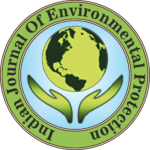IJEP 44(3): 257-264 : Vol. 44 Issue. 3 (March 2024)
Pappu Kumar1*, Saurabh Kumar2, Monu Kumar2, Anurag Chaubey2 and Jaiprakash Nayak3
1. Sandip University, Department of Civil Engineering, Madhubani – 847 235, Bihar, India
2. IIMT University, Department of Civil Engineering, Meerut – 250 001, Uttar Pradesh, India
3. Harcourt Butler Technical University, Department of Civil Engineering, Kanpur – 208 002, Uttar Pradesh, India
Abstract
This study conducts a mathematical analysis of groundwater flow and solute transport modelling using MATLAB software. This analytical solution is used to solve advection-dispersion problems. A groundwater contamination problem has become the most sensitive area for research. Increasing pollution and the mathematical complexity of the problem make analytical solutions so challenging, time-consuming and tedious. The objective of groundwater modelling is to analyse the numerical solution and Langmuir sorption isotherm. The solute transport model simulates the fate and transport of organic and inorganic contaminants in groundwater. A numerical groundwater problem is used as the input parameter. Hydraulic conductivity, density and porosity of the soil are the factors that determine sensitivity. Modelling of groundwater solute transport using MATLAB was carried out using mathematical partial differential equations for advection-dispersion and diffusion equations. The results obtained contaminant concentration variation with distances. MATLAB and other software can be used to solve the problem for ease of complexity.
Keywords
Groundwater contamination, Solute transport model, Advection-dispersion, MATLAB
References
- Bettenbrock, K., et al. 2006. A quantitative approach to catabolite repression in Escherichia coli. J. Biol. Chem., 281(5): 2578-2584.
- Barenblast, G. and Y. P. Zheltov. 1960. Fundamental equations of filtration of homogeneous liquids in fissured rocks. Soviet Phy. Doklady. 5 : 1- 522.
- Moench, A. F. 1984. Double porosity models for a fissured groundwater reservoir with fracture skin. Water Resour. Res., 20(7): 831-846.
- Kumar, G.S., M. Sekhar and D. Misra. 2008. Time-dependent dispersivity of linearly sorbing solutes in a single fracture with matrix diffusion. J. Hydrol. Eng., 13(4): 250-257.
- Hao, Y., P. Fu and C. R. Carrigan. 2013. Application of a dual-continuum model for simulation of fluid flow and heat transfer in fractured geothermal reservoirs. Workshop on geothermal reser. engineering. Proceedings, Vol. 1, pp 11-13.
- Taylor, G. I. 1953. Dispersion of soluble matter in solvent flowing slowly through a tube. Proc. Royal Soc. London. Series A, Mathemat. Physical Sci., 219(1137): 186-203.
- Parker, J. and M. T. Van Genuchten. 1984. Determining transport parameters from laboratory and field tracer experiments.
- Leij, F. J. and M. T. Van Genuchten. 2000. Analytical modelling of nonaqueous phase liquid dissolution with Green’s functions. Transport Porous Media. 38(1-2): 141-166.
- Jim Yeh, T. C. 1992. Stochastic modelling of groundwater flow and solute transport in aquifers. Hydrol. Processes. 6: 369-395.
- Carrera, J. 1993. An overview of uncertainties in modelling groundwater solute transport. J. Contamin. Hydrol., 13(1-4): 23-48.
- Swamee, P. K., S. K. Pathak and M. Sohrab. 2000. Empirical relations for longitudinal dispersion in streams. J. Env. Eng.,126(11): 1056-1062.
- Chapman, S. W. and B. L. Parker. 2005. Plume persistence due to aquitard back diffusion following dense nonaqueous phase liquid source removal or isolation. Water Resour. Res., 41(12).
- Amaziane, B., A. Bourgeat and M. Jurak. 2006. Effective macrodiffusion in solute transport through heterogeneous porous media. Multiscale Modelling Simul., 5(1): 184-204.
- Rhodes, M. E. and M. J. Blunt. 2006. An exact particle tracking algorithm for advective-dispersive transport in networks with complete mixing at nodes. Water Resour. Res., 42(4).
- Chopard, B., J. L. Falcone and J. Latt. 2009. The lattice Boltzmann advection-diffusion model revisited. The European Phy. J. Special Topics.171(1): 245-249.
- Li, Q., et al. 2009. COMSOL multiphysics: A novel approach to groundwater modelling. Ground Water. 47 (4): 480-487.
- Mangala, S. 2010. Groundwater solution techniques: Environmental application. J. Water Resour. Prot., 2(1): 8-13.
- Siebert, S. et al. 2010. Groundwater use for irrigation – a global inventory. Hydrol. Earth System Sci., 14(10): 1863-1880.
- Kumar, M. S., N. Kumar and P. K. 2011. Comparative study of analytical solutions for time-dependent solute transport along unsteady groundwater flow in semi-infinite aquifer. Int. J. Geosci., 2(4): 457-467.
- Zhang, Y. 2011. Groundwater flow and solute transport modelling. University of Myoming.
- Freeze, R. A. 1987. Groundwater (vol 12). Prentice~ Hall, Englewood I Cliffs, N.J. pp145-165.
- Klier, E. M., H. Meng and D. E. Angelaki. 2006. Three-dimensional kinematics at the level of the oculomotor plant. J. Neurosci., 26(10): 2732-2737.
- Daily, J. and D. Harleman 1966. Fluid dynamics. ed addison. Wesley Publish. Company.
- Taylor, G. I. 1954. The dispersion of matter in turbulent flow through a pipe. Proc. Royal Soc. London. Series A. Mathemat. Phy. Sci., 223: 1155446-1155468.
- Foy, W. H. 1976. Position-location solutions by Taylor-series estimation. IEEE Transactions on aerospace and electronic systems. pp 2187-194.
- Jumarie, G. 2006. Modified Riemann-Liouville derivative and fractional Taylor series of nondifferentiable functions further results. Computers Mathematics Appl., 51(9-10): 1367-1376.
- Lombardi, L., G. Antonini and A. E. Ruehli. 2018. Analytical evaluation of partial elements using a retarded Taylor series expansion of the Green’s function. IEEE Transactions Microwave Theory Techniques. 66(5): 2116-2127.
- Sun J., K. Lee and H. Lee. 2000. Comparison of implicit and explicit finite element methods for dynamic problems. J. Mater. Proces. Tech.,105(1-2): 110-118.
- Forsyth, P. A. 1991. A control volume finite element approach to NAPL groundwater contamination. SIAM J. Sci. Statistical Computing.12(5): 1029-1057.
- Sleep, B. E. and J. F. Sykes. 1993. Compositional simulation of groundwater contamination by organic compounds: 1. Model development and verification. Water resour. res., 1697-1708.
- Sanjaya, F. and S. Mungkasi. 2017. A simple but accurate explicit finite difference method for the advection-diffusion equation. IOP Conference Series: J. Phys., 909: 012038.
- Singh, M. K., A. Chatterjee and P. Kumari. 2018. Mathematical modelling of one-dimensional advection dispersion equation in groundwater contamination using different velocity and dispersion for different zones. In Applications of fluid dynamics. Ed M.K. Singh, B.S. Kushvah, G.S. Seth, J. Prakash. pp 585-592.
